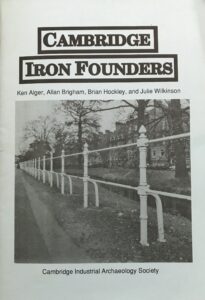Allan translated his passion for history into one for the city of Cambridge and our local history. He was a founding member of the Mill Road History Society and helped to frame the NLHF-funded Mill Road History Project. He researched and studied many Cambridge streets and buildings including much of the area around Mill Road. His accounts of the histories of Mill Road: 1823-1851, The Mill Road Depot, Donkey’s Common and Romsey Recreation Ground receive many viewings on the Capturing Cambridge website.
Tamsin Wimhurst
I love the pamphlet that he put together with others on the Cambridge Iron Founders. This is what I feel local history should all be about. Good primary research on an initially unassuming subject but one that takes you to very rich and interesting discoveries on the history of the area and its people.
Allan was interested in the ‘local’ at a time when very few were and when it was seen as being a ‘lesser’ form of historical research by many. It takes courage to forge ahead in this environment and stick up for the cause which he always did. It was wonderful that he got the recognition for his efforts and was one of the leading lights in our City.
Pam Halls, a former curator of the Museum and now curator of the Cambridge Museum of Technology
Whenever I see a bollard in Cambridge, I think of Allan. I first met him when I started work at the Folk Museum, now the Museum of Cambridge, back in the 1980s. He was a member of the Management Committee and at that time was collaborating with Ken Alger, Julie Wilkinson and Brian Hockley on a piece of research about Cambridge iron founding. The work included recording and categorising every cast iron bollard in town.
This was of special interest to me because many generations of my family had been employed in local ironworking businesses. As a child I had been taken on walks through town, and pieces of ironwork produced by family members were pointed out. I was amazed that anyone else would have any interest in this and that it could be a genuine subject for academic study. The research was eventually published as Cambridge Iron Founders in 1996. Twenty-four years later I am now responsible for a museum collection which includes many items made in Cambridge foundries, and this publication, complete with a comprehensive, illustrated survey of bollards, sits on my desk, faded and well-thumbed, as a constant reference.
